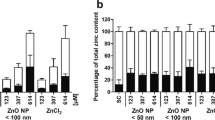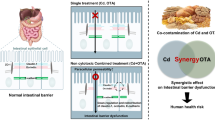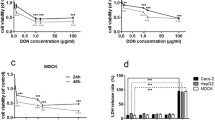Abstract
This study evaluated the use of IEC-6 cells as a model for studying lead (Pb) transport by intestinal epithelial cells (IECs) and examined potential transport mechanisms for Pb uptake and extrusion. Pb accumulation in IEC-6 cells exposed to 5 and 10 μM Pb for up to 60 min was time- and dose-dependent. Reduction of incubation temperature significantly reduced the total cellular Pb content of IEC-6 cells. Simultaneous exposure of cells to zinc (Zn) and Pb resulted in decreased total cellular Pb contents compared to total cellular Pb contents of cells exposed to Pb only. IEC-6 cells treated with ouabain (1 mM) or sodium azide (1 mM) and 5 μM Pb accumulated more Pb than cells exposed to Pb only. Cells treated withp-chloromercuribenzensulfonic acid (50 μM),p-chloromercuribenzoic acid (50 μM), or iodoacetimide (50 μM) accumulated less Pb than cells treated with Pb only. We conclude that Pb uptake by IEC-6 cells depends on the extracellular Pb concentration. Our data suggest that the mechanism of Pb uptake by IECs is complex, and that Pb transport in IEC-6 cells is time- and temperature-dependent, involves sulfhydryl groups, and is decreased by the presence of Zn. Extrusion of Pb is at least partially dependent on metabolic energy.
Similar content being viewed by others
References
J. C. Barton, Active transport of lead-210 by everted segments of rat duodenum,Am. J. Physiol.,247, G193-G198 (1984).
J. A. Blair, I. P. L. Coleman, and M. E. Hilburn, The transport of the lead cation across the intestinal membrane,J. Physiol. 286, 343–350 (1978).
K. A. Hussein, S. B. Coghill, G. Milne, and D. Hopwood, The uptake of lead by small intestine, colon and gallbladder of the guinea pig in vivo,Histochemistry 81, 591–596 (1984).
G. M. Nichols, A. R. Pearce, X. Alverez, N. K. Bibb, K. Y. Nichols, C. B. Alfred, and J. Glass, The mechanisms of nonheme iron uptake determined in IEC-6 rat intestinal cells,J. Nutr. 122, 945–952 (1992).
I. R. Sanderson, and Y. He, Nucleotide uptake and transport by intestinal epithelial cells,J. Nutr. 124, 131S-137S (1994).
Y. He, I. R. Sanderson, and W. A. Walker, Uptake, transport, and metabolism of exogenous nucleosides in intestinal epithelial cell cultures,J. Nutr. 124, 1942–1949 (1994).
S. A. McCormack, and L. R. Johnson, Putrescine uptake and release by a normal rat small intestinal crypt cell line, IEC-6,Exp. Cell. Res. 193, 241–252 (1991).
J. L. Scemama, V. Grabie, and E. R. Seidel, Characterization of univectorial polyamine transport in duodenal crypt cell line,Am. J. Physiol. 265, G851-G856 (1993).
K. Inui, A. Quaroni, L. G. Tillotson, and K. J. Isselbacher, Amino acid and hexose transport by cultured crypt cells from rat small intestine,Am. J. Physiol. 239, C190-C196 (1980).
A. Quaroni, J. Wands, R. L. Trelstad, and K. J. Isselbacher, Epithelioid cell cultures from rat small intestine,J. Cell. Biol. 80, 248–265 (1979).
C. W. Levenson, N. F. Shay, J. M. Hempe, and R. J. Cousins, Expression of cysteinerich intestinal protein in rat intestine and transfected cells is not zinc dependent,J. Nutr. 124, 13–17 (1994).
C. A. Drew, I. Spence, and G. A. R. Johnston, Effects of lead salts on the uptake, release, and binding of γ-aminobutyric acid: The importance of buffer composition,J. Neurochem. 52, 433–440 (1989).
F. Tacnet, D. W. Watkins, and P. Ripoche, Studies of zinc transport into brush-border membrane vesicles isolated from pig small intestine,Biochim. Biophys. Acta 1024, 323–330 (1990).
C. S. Fullmer, S. Edelstein, and R. H. Wassermann, Lead-binding properties of intestinal calcium-binding proteins,J. Biol. Chem. 260, 6816–6819 (1985).
M. E. Conrad, J. N. Umbreit, E. G. Moore, and C. R. Rodning, Newly identified iron-binding protein in human duodenal mucosa,Blood 79, 244–247 (1992).
D. J. Bobilya, M. Briske-Anderson, and P. G. Reeves, Zinc transport into endothelial cells is a facilitated process,J. Cell. Physiol. 151, 1–7 (1992).
E. C. Foulkes, Further findings on the mechanism of cadmium uptake by intestinal mucosal cells (step 1 of Cd absorption),Toxicology 70, 261–270 (1991).
T. J. B. Simons, Passive transport and binding of lead by human red blood cells,J. Physiol. 378, 267–286 (1986).
M. E. Conrad, and J. C. Barton, Factors affecting the absorption and excretion of lead in the rat,Gastroenterology 74, 731–740 (1978).
F. L. Cerklewski, and R. M. Forbes, Influence of dietary zinc on lead toxicity in rats,J. Nutr. 106, 689–696 (1976).
M. C. Rodriguez-Yoldi, J. E. Mesonero, and M. C. Rodriguez-Yoldi, Effect of zinc on aminopeptidaseN activity and L-threonine transport in rabbit jejunum,Biol. Trace Element Res. 53, 213–223 (1996).
R. H. Wasserman and C. S. Fullmer, Vitamin D and intestinal calcium transport: Facts, speculations and hypothesis,J. Nutr. 125, 1971S-1979S (1995).
E. D. Harris, Menkes' disease: Perspective and update on a fetal copper disorder,Nutr. Rev. 51, 235–245 (1993).
P. Oestreicher, and R. J. Cousins, Zinc uptake by basolated membrane vesicles from rat small intestine,J. Nutr. 119, 639–646 (1989).
Author information
Authors and Affiliations
Rights and permissions
About this article
Cite this article
Dekaney, C.M., Harris, E.D., Bratton, G.R. et al. Lead transport in IEC-6 intestinal epithelial cells. Biol Trace Elem Res 58, 13–24 (1997). https://doi.org/10.1007/BF02910662
Received:
Accepted:
Issue Date:
DOI: https://doi.org/10.1007/BF02910662




